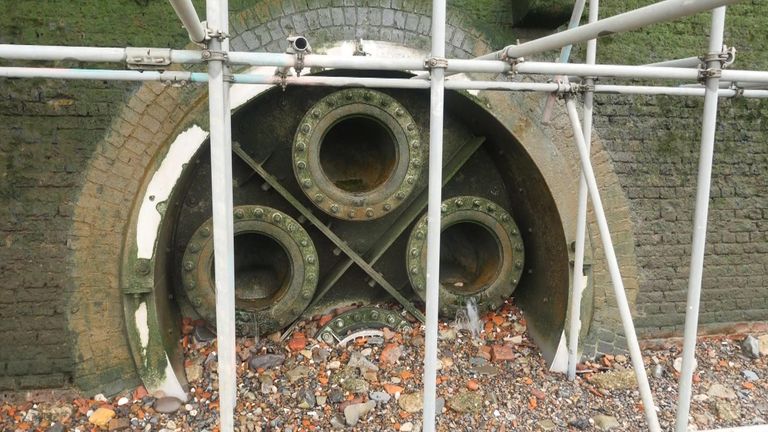Thames Tideway: Inside the £4bn ‘super sewer’ that will help protect London’s river from pollution | UK News
With a rattling clank the sliding doors shut on the makeshift lift and we start to track down the wall of the biggest vertical shaft I’ve ever seen.
A concrete tank 60 metres deep and 18 across dropping down to a tunnel junction beneath, its epic scale feels like something I’ve only seen on film: Dune or Bond.
The reality is less glamorous. It will fill with what we flush.
Sky News has been given rare access into the ‘super sewer’ or Thames Tideway, as it’s officially called.
It has three of these giant tanks along nearly 20 miles of tunnel, each wide enough to hold three double decker buses side by side.
Total build time will be nine years at a cost of around £4bn: an expensive solution to a massive problem.
In an average year, 39 million cubic metres of water contaminated with sewage is dumped into the River Thames.
London‘s Victorian sewers were built after the Great Stink of 1858, a stench from the river so bad that parliament couldn’t sit.
They were engineering marvels of their time, but over 100 years later a deliberate design decision has become a major flaw.
The foul water from our homes flows into the same pipes that carry rainwater running off roads and roofs. So downpours can overwhelm the system – especially as London has grown.
We have more people flushing toilets and more of those tile and tarmac hard surfaces. To prevent sewage backing up into homes, it is deliberately dumped in the river.
Lucy Webster, external affairs director for Thames Tideway, tells Sky News: “When they were designed, that would have been a very, very rare event.
“But today, with all its development, with population growth, it’s a very regular occurrence. And pretty much whenever it rains to any significant degree in London, it will be overflowing directly into the River Thames. “
Anger over ‘billowing brown plumes’
The super sewer will catch those overflows and send the sewage to a treatment plant in Beckton, east London and in a torrential downpour it’ll fill those huge tunnels. It’s like a new river network under London.
Paying for these costs each London household £18 per year – but polluted rivers and coasts are a national problem and, if it is to be solved, that bill will spread.
Campaign group Surfers Against Sewage recorded 14,000 untreated leaks last year and 700 incidents of human illness from sewage.
Billowing brown plumes in rivers and around our coasts have caused a popular and political outcry.
This week the government announced plans to make it easier to fine water companies for sewage leaks and many campaigners say they should find the money for the clean-up from their profits.
Read more from Sky News:
Criminal proceedings against Drax over dust exposure dropped
British leek supplies ‘exhausted by April’ in latest warning
Italy drought exposes walkway on Lake Garda
But Alastair Chisholm, director of policy at the Chartered Institute of Water and Environmental Management, says no one is being realistic about the scale and cost of the job nationwide.
“At the moment it’s looking like a bit of a car crash. We’ve got campaigners taking government to task. We’ve got government and other politicians shouting from the rooftops that they want to really punish the water companies.
“We’ve got the water companies needing to invest amounts of money that potentially are unaffordable for customers. There’s going to have to be a real reckoning with reality. And I think that’s going to come over the next 12 months.”
Click to subscribe to ClimateCast wherever you get your podcasts
The price for removing sewage from our natural waterways is high but nature is paying the price for doing nothing.
Chris Coode, from healthy river pressure group Thames 21, has witnessed the result of big leaks.
“You have a big slick of sewage in the river and as bacteria break down the organic matter they will use up oxygen,” he explains.
“So you’ll end up with huge areas of deoxygenated water. Fish can’t breathe, so you’ll see them sometimes at the edge, gasping. And you can have thousands of dead fish.”


